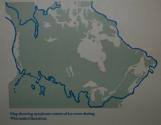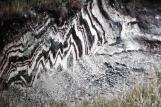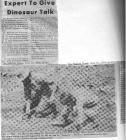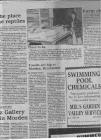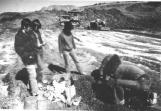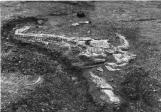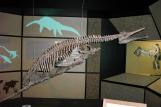7
As a result in global temperature change, the Western Interior Seaway retreated, leaving behind the organisms that once swam in its waters.Approximately 18,000 years ago, Earth experienced an ice age. A large massive sheet of ice covered almost all of Canada, as seen in the image.
Once the glacier retreated the rock layers embedded with the fossils from the Western Interior Seaway were exposed.
9
Eighty million years ago the bottom of the Western Interior Seaway was rich black clay. Over millions of years the layers of clay were buried and turned into a rock, shale. This cross section shows the rock layers of shale where the fossils are found within (black layers).Alternating layers of shale and bentonite represent episodes of volcanic activity from the west coast of North America, primarily from Montana. Bentonite is formed by heat and compaction of volcanic ash. Volcanic ash settled onto the sea floor while small particles of sediment that make up the shale began to accumulate on top of the volcanic ash, forming the alternating layers.
11
The Canadian Fossil Discovery Centre's (formerly Morden and District Museum) collection is so unique and abundant, many paleontologists have come to examine and excavate the material from within the bentonite quarries. The Royal Ontario Museum, the University of Manitoba and the Royal Tyrrell Museum have displays and material from the Pembina Hills area.13
The Canadian Fossil Discovery Centre's (formerly the Morden and District Museum) collection attracted a student from the University of Calgary pursuing her PhD. thesis on the Morden fauna.Elizabeth Nicholls spent three field seasons, from 1985 to 1987, in the quarries collecting and conducting research for her thesis. With the support of two summer helpers and Henry Isaak (Curator at the time), she helped bring in numerous specimens, some of which included the huge plesiosaur pelvic girdle currently on display.
Dr. Nicholls thinks the Morden and District Museum's collection is "one of the largest collections of marine reptiles from the seaway in one location".
15
With the help of the Pembina Mountain Clays mining company, previous Curator Henry Isaak, and volunteer high school students, the Canadian Fossil Discovery Centre (formerly the Morden and District Museum) has excavated over 500 specimens.The excavations are all from the Pembina Hills with discoveries still being made today.
17
One of the original specimens collected was an immature short-necked plesiosaur. The fauna swimming in the Western Interior Seaway may have fell subject to predation, disease or a cataclysmic event.The remains of an organism sink down to the seafloor. If the circumstances are ideal (rapid burial with no oxygen), the skeletal remains may be preserved and turned into a fossil.
Particles will settle down, covering the specimen. Over millions of years the specimen is buried by these tiny particles forming a rock. It is not until a geological event or climatic change occurs that the buried fossil may be exposed.
